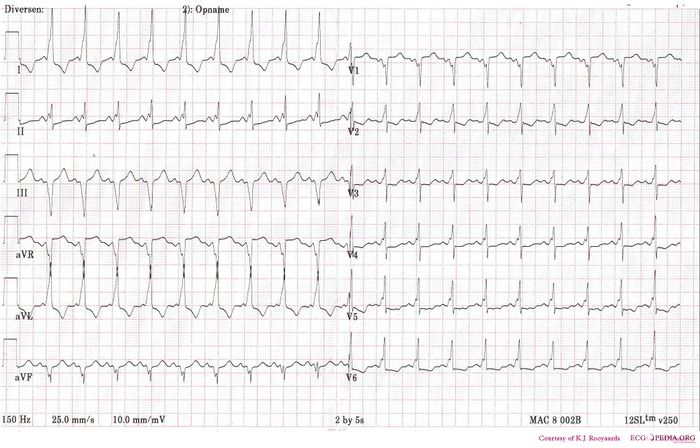Answer Case 2: Difference between revisions
Jump to navigation
Jump to search
m (New page: {{Case| |previouspage= Case 1 |previousname= Case 1 |nextpage= Case 3 |nextname= Case 3}} thumb| The ECG Try to interprete this ECG using the 7+2 step method ==Answe...) |
m (→Answer) |
||
| (One intermediate revision by the same user not shown) | |||
| Line 4: | Line 4: | ||
|nextpage= Case 3 | |nextpage= Case 3 | ||
|nextname= Case 3}} | |nextname= Case 3}} | ||
[[Image:KJcasus3.jpg|thumb| The ECG]] | [[Image:KJcasus3.jpg|thumb|left|700px| The ECG]] | ||
{{clr}} | |||
Try to interprete this ECG using the 7+2 step method | Try to interprete this ECG using the 7+2 step method | ||
==Answer== | ==Answer== | ||
| Line 11: | Line 12: | ||
***'''This is a regular rhythm and every QRS complex is preceded by a p wave. The p wave is positive in II,III, and AVF and thus originates from the sinus node. Conclusion: sinus rhythm.''' | ***'''This is a regular rhythm and every QRS complex is preceded by a p wave. The p wave is positive in II,III, and AVF and thus originates from the sinus node. Conclusion: sinus rhythm.''' | ||
**Hartfrequency | **Hartfrequency | ||
***'''Use the 'count the squares' method (a bit less than 3 large squares ~> 300-150-100), thus about 110 bpm.''' | ***'''Use the 'count the squares' method (a bit less than 3 large squares ~> 300-150-100), thus about 110 bpm and thus sinustachycardia.''' | ||
**Conduction (PQ,QRS,QT) | **Conduction (PQ,QRS,QT) | ||
***'''PQ-interval=0. | ***'''PQ-interval=0.10sec (2.5 small squares), QRS duration=0.10sec, QT interval=320ms''' | ||
**Hartaxis | **Hartaxis | ||
***'''Positive in I, II, III | ***'''Positive in I, II, negative in III and AVF. Thus a horizontal (normal) heart axis.''' | ||
**P wave morphology | **P wave morphology | ||
***'''The p wave is rather large in II, but does not fulfill the criteria for right atrial dilatation.''' | ***'''The p wave is rather large in II, but does not fulfill the criteria for right atrial dilatation.''' | ||
**QRS morphology | **QRS morphology | ||
***''' | ***'''The QRS shows a slurred upstroke or delta wave.''' | ||
**ST morphology | **ST morphology | ||
*** | ***Negative T wave in I and AVF. Flat ST in V3-V5.''' | ||
**Compare with the old ECG (not available, so skip this step) | **Compare with the old ECG (not available, so skip this step) | ||
**Conclusion? | **Conclusion? | ||
''' | '''[[Sinustachycardia]]] in a patient with a [[WPW|WPW pattern]]''' | ||
{{clr}} | {{clr}} | ||
Latest revision as of 15:15, 11 November 2008
| This page is part of Cases and Examples |
Try to interprete this ECG using the 7+2 step method
Answer
- Following the 7+2 steps:
- Rhythm
- This is a regular rhythm and every QRS complex is preceded by a p wave. The p wave is positive in II,III, and AVF and thus originates from the sinus node. Conclusion: sinus rhythm.
- Hartfrequency
- Use the 'count the squares' method (a bit less than 3 large squares ~> 300-150-100), thus about 110 bpm and thus sinustachycardia.
- Conduction (PQ,QRS,QT)
- PQ-interval=0.10sec (2.5 small squares), QRS duration=0.10sec, QT interval=320ms
- Hartaxis
- Positive in I, II, negative in III and AVF. Thus a horizontal (normal) heart axis.
- P wave morphology
- The p wave is rather large in II, but does not fulfill the criteria for right atrial dilatation.
- QRS morphology
- The QRS shows a slurred upstroke or delta wave.
- ST morphology
- Negative T wave in I and AVF. Flat ST in V3-V5.
- Compare with the old ECG (not available, so skip this step)
- Conclusion?
- Rhythm
Sinustachycardia] in a patient with a WPW pattern
